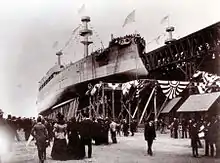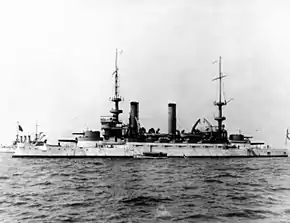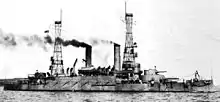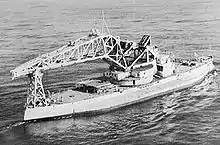USS Kearsarge (BB-5)
USS Kearsarge (BB-5), the lead ship of her class of pre-dreadnought battleships, was a United States Navy ship, named after the sloop-of-war Kearsarge. Her keel was laid down by the Newport News Shipbuilding Company of Virginia, on 30 June 1896. She was launched on 24 March 1898, sponsored by Mrs. Elizabeth Winslow (née Maynard), the wife of Rear Admiral Herbert Winslow, and commissioned on 20 February 1900.
%252C_converted_to_craneship_in_1920._Port_bow%252C_at_wharf%252C_09-18-1899_-_NARA_-_535431.jpg.webp) Kearsarge in 1899 | |
| History | |
|---|---|
| Name: | USS Kearsarge |
| Namesake: | USS Kearsarge (1861), a sloop named for Mount Kearsarge (Merrimack County, New Hampshire) made famous for defeating the CSS Alabama. |
| Awarded: | 2 January 1896 |
| Builder: | Newport News SB&DD |
| Cost: | US$5,043,591.68 |
| Laid down: | 30 June 1896 |
| Launched: | 24 March 1898 |
| Sponsored by: | Wife of Rear Admiral Herbert Winslow |
| Commissioned: | 20 February 1900 |
| Decommissioned: | 4 September 1909 |
| Identification: | Hull symbol: BB-5 |
| Recommissioned: | 23 June 1915 |
| Decommissioned: | 10 May 1920 |
| Renamed: | Crane Ship No. 1, 6 November 1941[lower-alpha 1] |
| Reclassified: | IX-16, 17 July 1920; AB-1, 5 August 1920[lower-alpha 1] |
| Stricken: | 22 June 1955 |
| Fate: | Sold for scrap, 9 August 1955 |
| Notes: | Only US battleship not named after a state |
| General characteristics | |
| Class and type: | Kearsarge-class pre-dreadnought battleship |
| Displacement: | 11,540 short tons (10,470 t) |
| Length: | 375 ft 4 in (114.40 m) |
| Beam: | 72 ft 3 in (22.02 m) |
| Draft: | 23 ft 6 in (7.16 m) |
| Installed power: | 5 boilers, 11,674 ihp (8,705 kW) |
| Propulsion: | 2 VTE engines, 2 propeller shafts |
| Speed: | 17 kn (20 mph; 31 km/h) |
| Boats & landing craft carried: | 6 cutters, 2 launches, 1 barge, 2 whaleboats, 1 gig, 2 dinghies, 2 catamarans |
| Complement: | 40 officers and 514 enlisted men |
| Armament: |
|
| Armor: |
|
Between 1903 and 1907 Kearsarge served in the North Atlantic Fleet, and from 1907 to 1909 she sailed as part of the Great White Fleet. In 1909 she was decommissioned for modernization, which was finished in 1911. In 1915 she served in the Atlantic, and between 1916 and 1919 she served as a training ship. She was converted into a crane ship in 1920, renamed Crane Ship No. 1 in 1941, and sold for scrap in 1955. She was the only United States Navy battleship to not be named after a state.
Design
The Kearsarge-class battleships were designed to be used for coastal defense.[1] They had a displacement of 11,540 short tons (10,470 t), an overall length of 375 feet 4 inches (114.40 m), a beam of 72 feet 3 inches (22.02 m) and a draft of 23 feet 6 inches (7.16 m).[2] The two 3-cylinder vertical triple-expansion steam engines and five Scotch boilers, connected to two propeller shafts, produced a total of 11,674 indicated horsepower (8,705 kW), and gave a maximum speed of 16.816 knots (19.352 mph; 31.143 km/h).[3] Kearsarge was manned by 40 officers and 514 enlisted men, a total of 554 crew.[4]
.jpg.webp)
Kearsarge had two double turrets, with two 13 in (330 mm)/35 caliber guns and two 8 in (203 mm)/40 caliber guns each, stacked in two levels.[5] The guns and turret armor were designed by the Bureau of Ordnance, while the turret itself was designed by the Bureau of Construction and Repair. This caused the guns to be mounted far back in the turret, making the ports very large. Admiral William Sims claimed that as a result, a shell fired into the port could reach the magazines below, disabling the guns.[6] In addition to these guns, Kearsarge carried fourteen 5 in (127 mm)/40 caliber guns, twenty 6-pounder (57 mm or 2.2 in) guns, eight 1-pounder (37 mm or 1.5 in) guns, four .30 in (7.6 mm) machine guns, and four 18 inch (450 mm) torpedo tubes.[2] Kearsarge had a very low freeboard, which resulted in her guns becoming unusable in bad weather.[7]
The ship's waterline armor belt was 5–16.5 inches (130–420 mm) thick and the main gun turrets were protected by 15–17 inches (380–430 mm) of armor, while the secondary turrets had 6–11 inches (150–280 mm) of armor. The barbettes were 12.5–15 inches (320–380 mm) thick, while the conning tower had 10 inches (250 mm) of armor.[2] The armor was made of harveyized steel.[3]
Kearsarge carried 16 smaller boats. A 40-foot (12 m) steam cutter, with a capacity of 60 men, together with a 33-foot (10 m) steam cutter, were used for general carrying from and to port, and could tow the other boats if needed. Two 33-foot launches, each capable of carrying 64 men, were the "working boats". There were ten 30-foot (9.1 m) boats: four cutters, each with a capacity of 45 men, the Admiral's barge, two whaleboats (which served as lifeboats), and the Captain's gig. Four smaller boats completed Kearsarge's small fleet: two 20-foot (6.1 m) dinghies and two 18-foot (5.5 m) catamarans.[8]
Construction

Kearsarge was authorized on 2 March 1895,[9] the contract for her construction was awarded on 2 January 1896,[10] and the keel of the vessel was laid down on 30 June 1896 by Newport News Shipbuilding & Dry Dock Company in Virginia.[2][11] The total cost was US$5,043,591.68.[3] She was named soon after the American Civil War sloop-of-war Kearsarge, and was the first ship of the United States Navy to be named by act of Congress. She was the only US battleship not named after a state.[12] She was christened on 24 March 1898 (the same day as her sister ship, Kentucky) by Mrs. Elizabeth Winslow (née Maynard), the wife of Captain Herbert Winslow,[11] daughter-in-law of Captain John Ancrum Winslow, the commander of the original Kearsarge.[13] She was commissioned on 20 February 1900, under the command of Captain William M. Folger.[14]
Service history
Early career
As flagship of the North Atlantic Squadron,[15] Kearsarge sailed along the Atlantic seaboard and the Caribbean Sea.[16] In May 1901 Captain Bowman H. McCalla assumed command of Kearsarge,[17] although by May 1902 the ship was being commanded by Captain Joseph Newton Hemphill.[18] Reassigned as flagship of the European Squadron, she sailed from Sandy Hook on 3 June 1903, on her way to Kiel, Germany.[19] She was visited by Emperor Wilhelm II of Germany on 25 June,[20] and by the Prince of Wales – who would later become King George V of the United Kingdom – on 13 July.[21]
Kearsarge returned to Bar Harbor, Maine, on 26 July,[22] and resumed her position as flagship.[23] On 1 December the ship sailed from New York for Guantánamo Bay, Cuba, where she was present as the United States took formal possession of the Guantanamo Naval Reservation on 10 December.[24][25] On 26 March 1904 Captain Raymond P. Rodgers assumed command of the ship.[26] Following maneuvers in the Caribbean Sea,[16] Kearsarge left with the North Atlantic Squadron for Lisbon, Portugal, where she met King Carlos I of Portugal on 11 June 1904.[27] Independence Day was celebrated in Phaleron Bay, Greece, with King George I of Greece and his son and daughter-in-law, Prince Andrew of Greece and Denmark and Princess Alice of Battenberg.[16] The squadron visited Corfu,[28] Trieste,[28] and Fiume[29] before returning to Newport, Rhode Island, on 29 August 1904.[16]
On 31 March 1905, Maine replaced Kearsarge as flagship of the North Atlantic Fleet,[30] although she remained with the fleet.[16] Captain Herbert Winslow took command of the ship during December.[31] On 13 April 1906, while participating in an exercise off Cape Cruz, Cuba, the gunpowder in a 13-inch gun ignited accidentally, killing two officers and eight men.[32][33]
Great White Fleet

Attached to the Fourth Division of the Second Squadron,[34] and under command of Captain Hamilton Hutchins,[35] she sailed on 16 December 1907 with the Great White Fleet.[36] The fleet left from Hampton Roads,[36] passed by Trinidad and Rio de Janeiro,[37] and then passed through the Straits of Magellan.[38] From there she passed by the west coast of South America, visiting Punta Arenas[39] and Valparaíso, Chile,[40] Callao, Peru,[41] and Magdalena Bay, Mexico.[42] The fleet reached San Diego on 14 April 1908[43] and moved on to San Francisco on 6 May.[44] Two months later the warships sailed for Honolulu, Hawaii,[45] and from there to Auckland, New Zealand, arriving 9 August.[46] The fleet made Sydney, Australia, on 20 August, and after a week sailed for Melbourne.[47]
Kearsarge departed Albany, Western Australia, on 18 September for ports in the Philippine Islands, Japan, China, and Ceylon before transiting the Suez Canal.[48] The fleet split at Port Said, with Kearsarge leaving on 10 January 1909 for Malta, and arriving in Algiers on 24 January, before reforming with the fleet at Gibraltar on 1 February. She returned to Hampton Roads on 22 February, and was inspected by U.S. President Theodore Roosevelt.[49]
World War I

As with most of the Great White Fleet ships, Kearsarge was modernized on her return.[50] She was decommissioned at the Philadelphia Naval Shipyard on 4 September 1909,[4] and the modernization was completed in 1911, at a cost of US$675,000.[51] The ship received cage masts, new water-tube boilers, and another four 5-inch guns. The 1-pounder guns were removed, as were sixteen of the 6-pounders.[7] She was recommissioned on 23 June 1915,[4] and operated along the Atlantic coast. On 17 September she left Philadelphia to land a detachment of US Marines at Veracruz, Mexico, remaining there from 28 September 1915 to 5 January 1916.[16] She then carried the Marines to New Orleans, Louisiana,[16] before joining the Atlantic Reserve Fleet at Philadelphia on 4 February.[4] Until the United States joined World War I, she trained naval militia from Massachusetts and Maine. During the war she was used to train Armed Guard crews and naval engineers during cruises along the Atlantic seaboard.[16] On 18 August 1918 Kearsarge rescued 26 survivors of the Norwegian barque Nordhav which had been sunk by U-117, bringing them to Boston.[52]
Inter-war period

Between 29 May and 29 August 1919, Kearsarge trained United States Naval Academy midshipmen in the Caribbean. Kearsarge sailed from Annapolis, Maryland to the Philadelphia Navy Yard, where she decommissioned on either 10 May[16][53][54] or 18 May 1920.[10][9]
Kearsarge was converted into a crane ship, and was given hull classification symbol IX-16 on 17 July 1920,[55] but it was changed to AB-1 on 5 August.[53][lower-alpha 1] Her turrets, superstructure, and armor were removed, and were replaced by a large revolving crane with a lifting capacity of 250 tons (230 tonnes), as well as 10-foot (3.0 m) blisters, which improved her stability.[56] The crane ship was utilized often over the next 20 years, including the raising of USS Squalus in 1939.[54]
World War II
On 6 November 1941, Kearsarge was renamed Crane Ship No. 1, allowing her name to be given to Hornet (CV-12), and later to Kearsarge (CV-33).[54] She continued her service, however, handling guns, turrets, armor, and other heavy lifts for vessels such as Indiana,[57] Alabama, Savannah, Chicago, and Pennsylvania.[4]
She was transferred to the San Francisco Naval Shipyard in 1945, where she participated in the construction of Hornet and Boxer and the re-construction of Saratoga.[16] One of her last projects was performing heavy lifts during the reassembly of another crane vessel, YD-171 (ex-Schwimmkran nr. 1) on Terminal Island.[58] In 1948 she left the West Coast for the Boston Naval Shipyard.[59] On 22 June 1955 her name was struck from the Naval Vessel Register, and she was sold for scrap on 9 August.[35] Kearsarge's figurehead is on display in Dahlgren Hall at the United States Naval Academy.
Awards
Footnotes
Notes
- From the time of its conversion to a crane ship, the classification and naming of Kearsarge is highly problematic. The Dictionary of American Naval Fighting Ships mentions that Kearsarge was reclassified as AB-1 on 5 August 1920, and that it was renamed to Crane Ship No. 1 on 6 November 1941.[lower-alpha 2] This is repeated by a number of other sources.[lower-alpha 3][lower-alpha 4][lower-alpha 5] However, the symbol AB was not used in 1920: Roberts claims the symbol was created in 1931,[lower-alpha 6] while Reilly and Scheina claim it was established even later, in 1939.[lower-alpha 7] According to Reilly and Scheina, on 5 August 1920 Kearsarge (BB-5) became Kearsarge (Crane Ship No. 1), with the "Crane Ship" serving instead of a different designation, and on 15 April 1939,[lower-alpha 8] when the AB designation was adopted, she became Kearsarge (AB-1). In 1941, when the name Kearsarge was wanted for other ships, she was renamed, and she became Crane Ship No. 1 (AB-1).[lower-alpha 7] The IX-16 classification is also uncertain. Bauer and Roberts report that Kearsarge was reclassified as IX-16 on 17 July 1920, before being classified AB-1 on 15 April 1939,[lower-alpha 9] although Roberts also claims that the designation IX-16 may have been used for USS Tallahassee (BM-9) between 1921 and 1922, and that this was before it was used for Kearsarge.[lower-alpha 6] However, a number of other sources also mention Kearsarge being designated IX-16.[lower-alpha 10][lower-alpha 11]
- DANFS Kearsarge (BB-5).
- Friedman 1985, p. 419.
- Newhart 1995, p. 21.
- Albertson 2007, p. 179.
- Roberts 2010.
- Reilly & Scheina 1980, p. 93.
- Reilly & Scheina 1980, p. 83.
- Bauer & Roberts 1991, p. 103.
- Fitzsimons 1978, p. 1581.
- Polmar 2005, p. 242.
Citations
- Crawford 2008, p. 12.
- Chesneau, Koleśnik & Campbell 1979, p. 141.
- Reilly & Scheina 1980, p. 94.
- Newhart 1995, p. 21.
- Friedman 1985, pp. 30–32.
- Friedman 1985, p. 17.
- Reilly & Scheina 1980, p. 92.
- New-York Tribune 6 May 1900.
- Reilly & Scheina 1980, p. 83.
- NVR Crane Ship No. 1 (AB 1).
- Houston Daily Post 25 March 1898.
- Friedman 1985, p. 30.
- The New York Times 26 September 1914.
- Times 20 February 1900.
- Albertson 2007, p. 178.
- DANFS Kearsarge (BB-5).
- Times 17 March 1901.
- New-York Tribune 29 May 1902.
- New-York Tribune 4 June 1903.
- St. Louis Republic 26 June 1903.
- The San Francisco Call 14 July 1903.
- The San Francisco Call 27 July 1903.
- The Washington Times 3 August 1903.
- The San Francisco Call 2 December 1903.
- The San Francisco Call 11 December 1903.
- Evening Bulletin 26 March 1904.
- St. Louis Republic 12 June 1904.
- Evening Star 8 July 1904.
- Edgefield Advertiser 3 August 1904.
- Evening Star 24 March 1905.
- Evening Star 13 December 1905.
- Pensacola Journal 21 April 1905.
- New-York Tribune 24 April 1905.
- Albertson 2007, p. 46.
- Albertson 2007, p. 177.
- Albertson 2007, p. 181.
- Albertson 2007, p. 54.
- Albertson 2007, p. 66.
- Albertson 2007, p. 64.
- Albertson 2007, p. 67.
- Albertson 2007, p. 69.
- Albertson 2007, p. 73.
- Albertson 2007, p. 184.
- Albertson 2007, p. 185.
- Albertson 2007, pp. 90–95.
- Albertson 2007, p. 95.
- Albertson 2007, p. 188.
- Albertson 2007, pp. 188–190.
- Albertson 2007, pp. 191–192.
- Friedman 1985, p. 82.
- Friedman 1985, pp. 82–83.
- Daniels 1920, p. 95.
- Friedman 1985, p. 419.
- Albertson 2007, p. 179.
- Bauer & Roberts 1991, p. 103.
- Graff 2010, p. 54.
- Garzke & Dulin 1995, p. 72.
- Popular Mechanics & September 1948.
- Morris & Kearns 2011, p. 206.
Bibliography
Books
- Albertson, Mark (2007). They'll Have to Follow You!: The Triumph of the Great White Fleet. Mustang, Oklahoma: Tate Publishing & Enterprises. ISBN 978-1-60462-145-7.CS1 maint: ref=harv (link)
- Bauer, Karl Jack; Roberts, Stephen S. (1991). Register of Ships of the U.S. Navy, 1775–1990: Major Combatants. Westport, Connecticut: Greenwood Publishing Group. p. 103. ISBN 0-313-26202-0.CS1 maint: ref=harv (link)
- Chesneau, Roger; Koleśnik, Eugène M.; Campbell, N.J.M. (1979). Conway's All the World's Fighting Ships, 1860–1905. London: Conway Maritime Press. ISBN 0-85177-133-5.CS1 maint: ref=harv (link)
- Crawford, Michael J. (2008). The World Cruise of the Great White Fleet: Honoring 100 Years of Global Partnerships and Security. Washington, D.C.: United States Government Printing Office. ISBN 978-0-945274-59-9.CS1 maint: ref=harv (link)
- Daniels, Josephus, ed. (1920). German Submarine Activities on the Atlantic Coast of the United States and Canada (PDF). Washington, D.C.: United States Government Printing Office. p. 95. ISBN 1-78039-135-8. Retrieved 13 January 2013.
- Fitzsimons, Bernard (1978). The Illustrated Encyclopedia of 20th Century Weapons and Warfare. 15. Milwaukee: Purnell Reference Books. p. 1581. ISBN 978-0-8393-6175-6.CS1 maint: ref=harv (link)
- Friedman, Norman (1985). U.S. Battleships, An Illustrated Design History. Annapolis, Maryland: Naval Institute Press. ISBN 0-87021-715-1.CS1 maint: ref=harv (link)
- Garzke, William H., Jr.; Dulin, Robert O., Jr. (1995). Battleships: United States Battleships, 1935–1992 (2nd revised and illustrated ed.). Annapolis, Maryland: Naval Institute Press. p. 72. ISBN 1-55750-174-2.CS1 maint: ref=harv (link)
- Graff, Cory; Puget Sound Navy Museum (2010). The Navy in Puget Sound. Charleston, South Carolina: Arcadia Publishing. p. 54. ISBN 978-0-7385-8081-4.
- Morris, James Matthew; Kearns, Patricia M. (2011). "Kearsarge, USS (BB5), battleship". Historical Dictionary of the United States Navy (2nd ed.). Lanham, Maryland: Scarecrow Press. p. 206. ISBN 978-0-8108-7229-5.CS1 maint: ref=harv (link)
- Newhart, Max R. (1995). American Battleships: A Pictorial History of BB-1 to BB-71. Missoula, Montana: Pictorial Histories Publishing Company. ISBN 978-1-57510-004-3.CS1 maint: ref=harv (link)
- Polmar, Norman (2005). The Naval Institute Guide to the Ships and Aircraft of the U.S. Fleet (18th ed.). Annapolis, Maryland: Naval Institute Press. p. 242. ISBN 978-1-59114-685-8.
- Reilly, John C.; Scheina, Robert L. (1980). American Battleships 1886–1923: Predreadnought Design and Construction. Annapolis, Maryland: Naval Institute Press. ISBN 0-87021-524-8.CS1 maint: ref=harv (link)
- Sieche, Erwin F. (1990). "Austria-Hungary's Last Visit to the USA". Warship International. XXVII (2): 142–164. ISSN 0043-0374.
Newspapers
- "Kentucky is Launched" (PDF). Houston Daily Post. 25 March 1898. p. 4. Retrieved 1 January 2013.
- "The New Kearsarge" (PDF). Times. Washington, D.C. 20 February 1900. p. 5. Retrieved 11 January 2013.
- "A Battleship's Boats" (PDF). New-York Tribune. 6 May 1900. p. 21. Retrieved 21 April 2013.
- "M'Calla Ordered Home" (PDF). Times. Washington, D.C. 17 March 1901. p. 13. Retrieved 15 April 2013.
- "A Dinner in Their Honor" (PDF). New-York Tribune. 29 May 1902. p. 3. Retrieved 15 April 2013.
- "The Kearsarge Off for Kiel" (PDF). New-York Tribune. 4 June 1903. p. 3. Retrieved 14 January 2013.
- "Kaiser Warmly Praises Visiting American Fleet" (PDF). St. Louis Republic. 26 June 1903. p. 1. Retrieved 11 January 2013.
- "Prince of Wales a Guest Aboard the Kearsarge" (PDF). The San Francisco Call. 14 July 1903. p. 3. Retrieved 11 January 2013.
- "Kearsarge Ends Her Ocean Race" (PDF). The San Francisco Call. 27 July 1903. p. 3. Retrieved 11 January 2013.
- ""Enemy's" Fleet Leaves Bar Harbor for the Mimic War" (PDF). The Washington Times. 3 August 1903. p. 1. Retrieved 11 January 2013.
- "Battleships Begin Winter Cruise" (PDF). The San Francisco Call. 2 December 1903. p. 3. Retrieved 11 January 2013.
- "Formal Occupancy of Guantanamo" (PDF). The San Francisco Call. 11 December 1903. p. 11. Retrieved 11 January 2013.
- "To Command the Kearsarge" (PDF). Evening Bulletin. Maysville, Kentucky. 26 March 1904. p. 1. Retrieved 15 April 2013.
- "Extraordinary Honors for American Squadron" (PDF). St. Louis Republic. 12 June 1904. p. 11. Retrieved 14 January 2013.
- "Warships in the Adriatic" (PDF). Evening Star. Washington, D.C. 8 July 1904. p. 1. Retrieved 16 January 2013.
- "Foreign Affairs" (PDF). Edgefield Advertiser. 3 August 1904. p. 1. Retrieved 16 January 2013.
- "To Engage in Target Practice" (PDF). Evening Star. Washington, D.C. 24 March 1905. p. 5. Retrieved 15 April 2013.
- "To Command the Kearsarge" (PDF). Evening Star. Washington, D.C. 13 December 1905. p. 17. Retrieved 15 April 2013.
- "Admiral Evans on the Kearsarge Explosion" (PDF). Pensacola Journal. 21 April 1905. p. 1. Retrieved 11 January 2013.
- "Naval Funeral for Lieut. Graeme" (PDF). New-York Tribune. 24 April 1905. p. 7. Retrieved 11 January 2013.
- "Admiral H. Winslow Dead" (PDF). The New York Times. 26 September 1914. Retrieved 10 January 2013.
Online resources
- "Kearsarge". Dictionary of American Naval Fighting Ships. Navy Department, Naval History and Heritage Command. Retrieved 13 January 2017.
- "Crane Ship No. 1 (AB 1)". Naval Vessel Register. United States Navy. Retrieved 11 January 2013.
- Roberts, Stephen S. (December 2010). "Unclassified (IX), Special Types". Register of Ships of the U.S. Navy: Auxiliary Vessels 1884–1945. Retrieved 31 January 2013.CS1 maint: ref=harv (link)
- "One Crane Builds Another". Popular Mechanics. Vol. 90 no. 3. Popular Mechanics Company. September 1948. pp. 96–97. Retrieved 18 November 2016.
Further reading
- Alden, John D. (1989). American Steel Navy: A Photographic History of the U.S. Navy from the Introduction of the Steel Hull in 1883 to the Cruise of the Great White Fleet. Annapolis, Maryland: Naval Institute Press. ISBN 0-87021-248-6.
External links
| Wikimedia Commons has media related to USS Kearsarge (BB-5). |
- Naval Historical Center USS Kearsarge (Battleship # 5), 1900–1955. Later Crane Ship # 1 (AB-1).
- MaritimeQuest USS Kearsarge BB-5 Photo Gallery
- Photo gallery of Kearsarge at NavSource Naval History
- Rough Log Book of the U.S.S. Kearsarge, 1901 MS 314 held by Special Collections & Archives, Nimitz Library at the United States Naval Academy